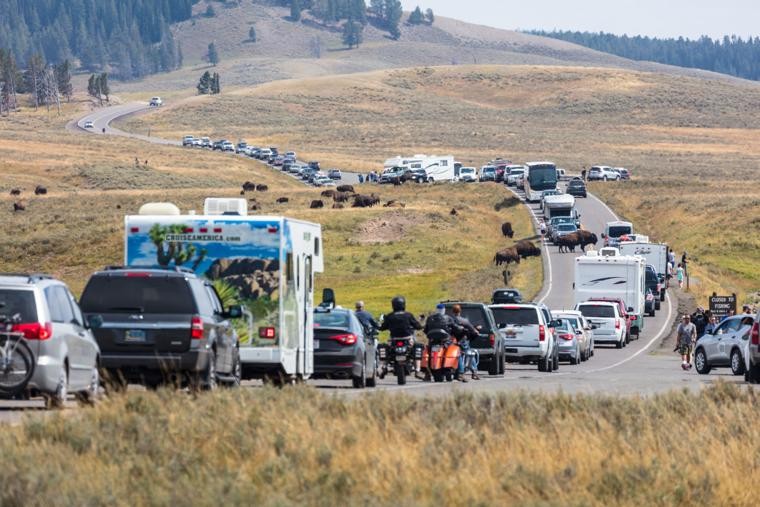The frustrated tourist stalled in the long bison jam in Yellowstone National Park is more likely to be a repeat visitor, according to a newly released survey.
That’s just one of the findings in Yellowstone’s 2018 Visitor Use Study, which also found the majority of visitors surveyed — 67 percent — were first-time visitors, and that the longer those first-time visitors stayed in the park, the more frustrated they became by perceived crowding problems.
“I’m quite surprised how well they are willing to accept crowding,” said Jeremy Sage, an economist and associate director of the University of Montana Institute for Tourism Recreation Research, a part of the research team. “As you get more and more experience with it, the newness wears off.”
New study
The National Park Service contracted Otak Inc., RRC Associates and ITRR to conduct the study to help understand how visitors experience the park in real time, across the summer season, and across different parts of the park. More than 4,000 people responded to the surveys, one of the largest in the history of the National Park Service. It was conducted during one week of each month from May through September 2018.
Overall, the picture produced was fairly rosy. Eighty-five percent of respondents thought their experience in the park was good or excellent. The top three reasons for visiting were scenery, wildlife and thermal features — all of which Yellowstone has in great variety.
“I largely credit the National Park Service team and our partners for the high visitor satisfaction levels,” said Superintendent Cam Sholly in a news release. “That said, there is no question that increasing visitation levels are having higher impacts on resources, our staff and infrastructure, and our gateway communities.”
Deal with it
Understanding tourists’ behavior and their satisfaction is important to the Park Service as visitation has steadily climbed in the past 10 years, peaking at 4.2 million in 2016. One problem the survey noted was a greater sense of crowding, traffic congestion and parking availability at Midway Geyser Basin and Fairy Falls. That’s the type of problem the agency may be able to address with new infrastructure.
The solution to such a problem may be local shuttle systems between Old Faithful to West Yellowstone, Old Faithful to the geyser basin and back, and Canyon Village to various local attractions.
“This study gives us very actionable information on how we can better manage and plan for increasing visitation in Yellowstone,” Sholly said.
Other info
It’s also worth noting that repeat visitors said in the survey they were more likely to want to experience a wild place while in Yellowstone, as opposed to visiting geysers and thermal features that were high on the list of newbies maybe making a quick trip around the Grand Loop.
As Chinese tourism has climbed, the survey also dug into their experiences, noting that they valued being around “considerate people,” wanted to feel safe, and appreciated clean restrooms more than their United States counterparts.
Chinese visitation by tour bus places an unusual demand on park resources, Sage noted, with big surges of tourists.
“Overall, 92 percent waited less than 10 minutes to enter the park and 86 percent waited less than 10 minutes to find parking,” according to a park press release. “Of the more popular sites in the park, respondents rated Old Faithful and Canyon Village the least problematic, probably due to sufficient infrastructure to support a high volume of visitors.”



